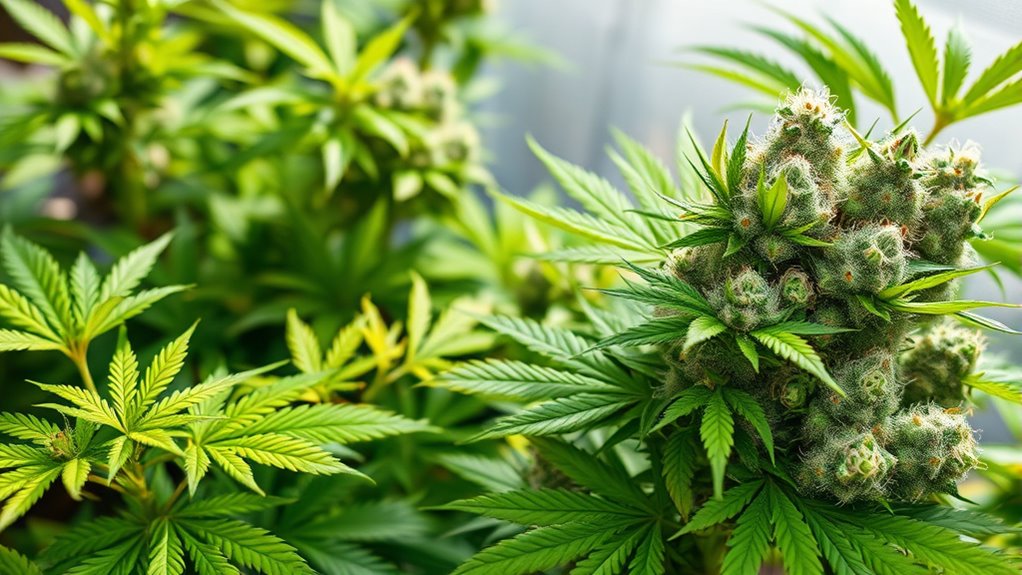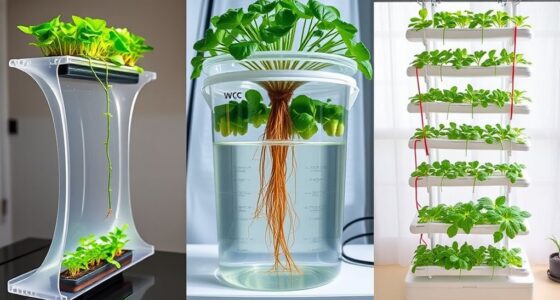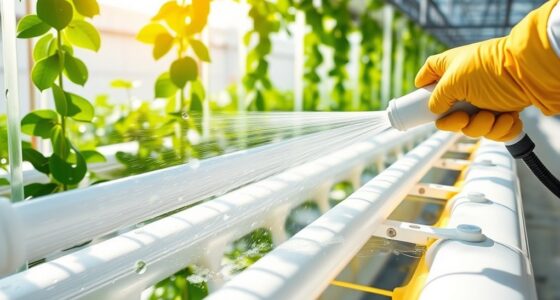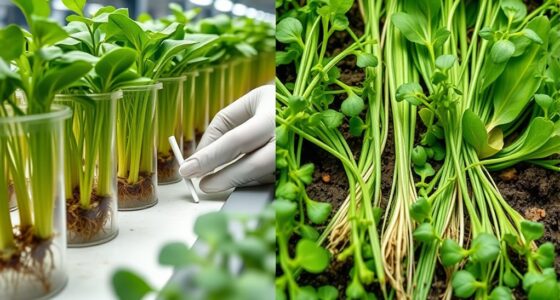To dial in N-P-K ratios from seedling to bloom, you need to adjust nutrients at each stage. Start with higher nitrogen for healthy foliage during seedlings, then increase phosphorus and potassium during vegetative growth. As you shift to flowering, reduce nitrogen and boost phosphorus and potassium to promote buds and blooms. Maintaining these tailored ratios helps your plant thrive through every phase. Keep exploring ways to optimize your feeding schedule for best results.
Key Takeaways
- Adjust N-P-K ratios according to growth stage: high nitrogen early, then increased phosphorus and potassium during flowering.
- Use approximately 3-1-2 for seedlings, shifting to 4-2-3 in vegetative, and 1-3-4 during flowering.
- Reduce nitrogen during flowering to prevent excessive foliage, while boosting phosphorus and potassium for blooms.
- Organic amendments like compost support nutrient uptake at all stages, enhancing plant health.
- Monitoring plant response ensures timely adjustments for optimal nutrient balance throughout growth.

Have you ever wondered how to optimize your plant’s nutrition throughout its growth cycle? Understanding the right balance of nitrogen (N), phosphorus (P), and potassium (K) at each stage is essential. These three nutrients form the foundation of plant health and influence everything from root development to flowering. By dialing in the correct N-P-K ratios, you give your plants exactly what they need when they need it, leading to stronger growth and better yields.
During the seedling stage, your plant’s primary focus is establishing a healthy root system and developing strong foliage. Here, nitrogen should be the star. It encourages lush, green growth and helps the plant build a solid framework. You want a fertilizer with a higher nitrogen content, such as a ratio like 3-1-2 or similar, to support rapid leaf and stem development. But be cautious—too much nitrogen early on can cause overly lush, tender growth that’s vulnerable to pests or diseases. Keep the balance delicate, providing enough to promote vigorous growth without overwhelming the plant. Incorporating natural materials like compost or organic amendments can further enhance healthy seedling development.
During the seedling stage, prioritize nitrogen to promote healthy root and foliage development.
As your plant moves into the vegetative stage, its demand for nutrients shifts. It now needs to develop a sturdy structure to support future flowering. During this phase, you should continue emphasizing nitrogen but start increasing phosphorus slightly. Phosphorus fuels root growth, energy transfer, and overall vigor. An N-P-K ratio like 4-2-3 can be effective, ensuring your plant has the nutrients it needs for robust growth and strong stems. Potassium also plays a critical role in strengthening cell walls and improving overall resilience. At this stage, a balanced approach works best—providing enough nitrogen to sustain lush foliage while boosting phosphorus and potassium to prepare for flowering.
When your plant transitions into the flowering or blooming stage, its nutritional needs change dramatically. It now requires less nitrogen and more phosphorus and potassium to support flower development and fruiting. Phosphorus promotes bud formation and enhances flowering quality, while potassium improves the overall health of the plant, aids in nutrient transport, and increases resistance to stress. You might switch to a fertilizer with a ratio like 1-3-4 or similar, emphasizing phosphorus and potassium. This shift encourages your plant to focus energy on producing flowers, increasing the size, density, and potency of your buds. Maintaining good lighting and ensuring proper air circulation will also optimize flowering success.
Frequently Asked Questions
How Do Soil Ph Levels Affect Nutrient Uptake During Different Growth Stages?
Soil pH levels directly impact nutrient uptake by affecting how plants absorb minerals. If the pH is too low or high, certain nutrients become less accessible, causing deficiencies at different growth stages. During seedling and vegetative stages, a slightly acidic to neutral pH helps nutrients like nitrogen and phosphorus stay available. In flowering, adjusting pH guarantees elements like potassium are accessible, supporting healthy blooms and overall plant health.
Are Organic Fertilizers Suitable for All Growth Stages?
Yes, organic fertilizers are suitable for all growth stages. They provide essential nutrients gradually, supporting your plants from seedling to bloom. You can apply compost, manure, or other organic options to guarantee steady nutrient release. Organic fertilizers improve soil health over time, encouraging strong root development and vibrant flowering. Just remember to adjust application rates based on your plant’s specific needs at each stage for ideal results.
How Can I Prevent Nutrient Deficiencies in My Plants?
To prevent nutrient deficiencies, you should regularly test your soil and monitor your plants for signs like yellowing leaves or stunted growth. Make certain you’re providing a balanced fertilizer tailored to your plant’s needs at each growth stage. Keep consistent watering and avoid over-fertilizing, which can cause imbalances. By staying attentive and adjusting nutrients as needed, you’ll help your plants stay healthy and thrive throughout their lifecycle.
What Are the Signs of Over-Fertilization at Various Stages?
Over-fertilization is like pouring too much paint on a canvas; it can drown your plant’s health. Signs include leaf burn, yellowing edges, and slow growth. During seedlings, look for stunted development; in vegetative stages, watch for dark, lush leaves that may turn crispy. During flowering, excessive nutrients can cause distorted buds and reduced yield. Keep a careful eye to prevent your plant from becoming a nutrient overload.
How Do Environmental Factors Influence Nutrient Requirements Throughout Growth?
Environmental factors like temperature, humidity, and light substantially influence your plant’s nutrient needs at each growth stage. Warmer conditions may increase nutrient uptake, so you should adjust feeding accordingly. High humidity can lead to nutrient imbalances, while strong light boosts photosynthesis, demanding more nutrients. Keep an eye on these factors, and tailor your fertilization schedule to optimize growth, prevent deficiencies, and avoid overfeeding.
Conclusion
As you nurture your plants through each growth stage, remember that understanding their N-P-K needs is like tuning a fine instrument—you’ll create a symphony of healthy growth. From seedling to bloom, adjusting your nutrients guarantees your garden’s story unfolds beautifully. Stay attentive to these stages, and your plants will flourish like a well-conducted orchestra, turning your efforts into a vibrant, thriving masterpiece. Keep nurturing, and watch your garden bloom with life.











